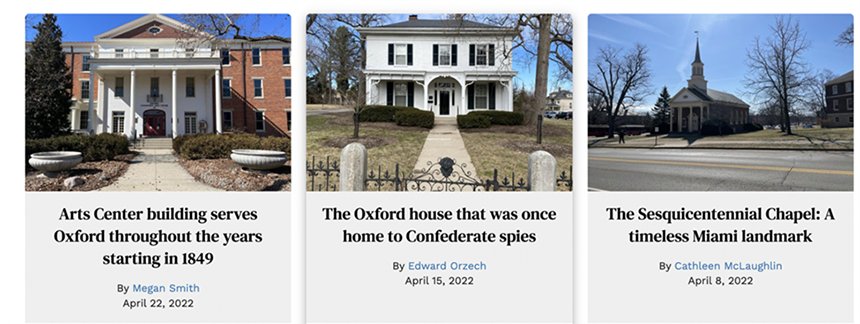Miami in the Media: Coverage in a News Desert
Assignment
Evaluating Miami Media Coverage in a Time of News Deserts
Students will be encouraged to use the Miami Student archive in Miami University’s digital collections to locate on-campus discussions of news stories of national interest. Equally, students will be encouraged to brainstorm on how recent on- and off-campus stories—such as the coverage of Miami during the COVID-19 pandemic—appeared within regional and national news media.
Taking the older stories, students will be encouraged to reflect on how matters of national concern – e.g., the Kennedy assassination, the events of September 11, 2001, the Fall of the Berlin Wall – were discussed by students on campus in an era before social media. Equally, students will be encouraged to look for on-campus stories reporting on “Miami” in the national news.
Then, with stories from the “social media era,” students can consider how (and whether) coverage of national stories on campus has changed – and, whether national perceptions of Miami have shifted.
This will encourage students to consider how Miami news can go viral and how negative news travels quickly in a social media era. While most days, no regional and national news cover Miami and Oxford, when sensational news does occur, numerous stories are published by media in Ohio, the United States and even the world.
While a viral story about COVID-19 might results in tens of millions of hits – and Miami’s story going global – consider that by comparison, a story about the 50th anniversary of Miami’s relationship with the Miami tribe in the received regional coverage (Cincinnati and Dayton) and has just 9 million hits.
Such comparisons will help students reflect on the way in which an institution, a business, a brand, a corporation – and even an individual – might face various challenges of coverage when social media algorithms and revenue-driven editorial offices replace traditional media sources.
Possible discussion questions:
- How did the coverage differ?
- How was the local story more complete and fair?
- How did the national and international news media cover it differently and more scarcely?
- How should this have been covered?
- How would this have been covered if we had professional (not just student) journalists covering Oxford and Miami University?
Learning Outcomes
- Identify a news desert and analyze the lack of news coverage impacts an area and the way it is covered.
- Compare news coverage from two universities – ones with local news, ones without.
- Critique how news organizations cover stories outside their coverage areas.
- Evaluate the tone and sourcing of news stories where reporters “drop in” to an area.
Archival Sources
In addition to considering the student and regional newspapers around other U.S. universities, students will be encouraged to draw upon the Miami Student archive in the digital collections of the Walter Havighurst Special Collections in King Library, Miami University.
